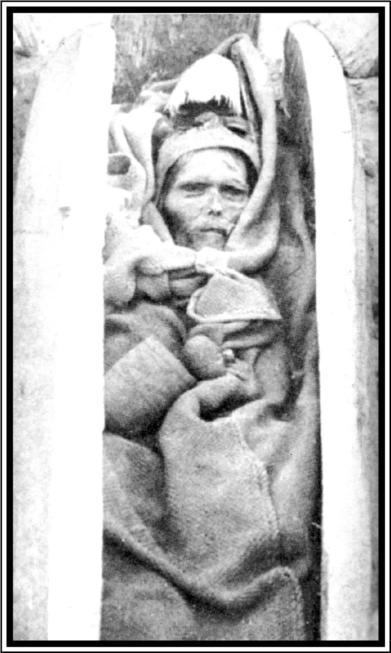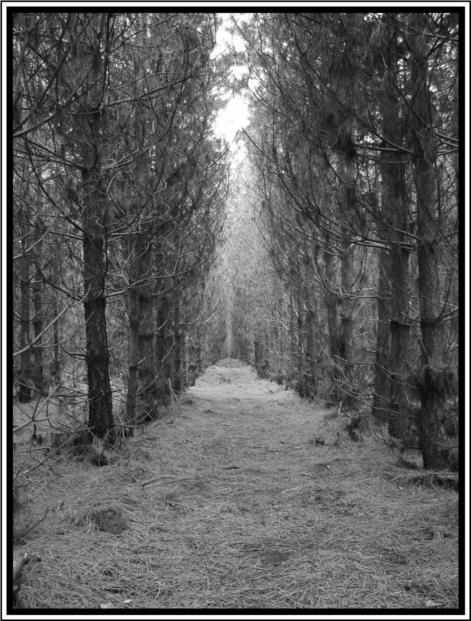Hidden History: Lost Civilizations, Secret Knowledge, and Ancient Mysteries (49 page)
Read Hidden History: Lost Civilizations, Secret Knowledge, and Ancient Mysteries Online
Authors: Brian Haughton
Tags: #Fringe Science, #Gnostic Dementia, #U.S.A., #Alternative History, #Amazon.com, #Retail, #Archaeology, #History



Tarim Basin mummy, photographed by Aurel Stein, c. 1910.
The Tarim Mummies constitute a
baffling ancient world mystery, and
one of the most remarkable archaeological finds of the 20th century. These
amazingly well-preserved human remains were found in the dry salty environment of the vast Taklimakan
desert, part of the Tarim Basin in western China. The bodies so far discovered
have an extremely wide date range,
from 1800 B.C. up until A.D. 400. But what
has captured the attention of scholars
all over the world is the fact that the
mummies have distinctly European features, and seem to represent various Caucasian tribes who lived in this
desolate area of western China up until 2,000 years ago, before mysteriously
disappearing.
The mummies were first discovered in the early 1900s by Swedish
explorer Sven Hedin, who was investigating the complex history of the Silk
Road, an ancient series of routes which
once led from China to Turkey and on
into Europe. But without the necessary equipment to either preserve the
bodies or transport them back to museums in Europe for study, they remained in situ and were soon forgotten.
In 1978, Chinese archaeologist Wang
Binghua excavated 113 of these bodies at a cemetery at Qizilchoqa, or Red
Hill, in the northeast corner of the central Asian province of Xinjiang. Most
of the bodies were later taken to a
museum in the city of Urumqi. In the
last 25 years or so, Chinese and
Uyghur archaeologists have carried
out sophisticated excavation and research in the area, and there are now
more than 300 of these mummies
known to have been discovered in western China. In 1987, Victor Mair (a professor of Chinese and Indo-Iranian
literature and religion at the University of Pennsylvania) was leading a
group of tourists through the museum
in Urumqi when he came upon some
of the mummies excavated by Wang
Binghua. He found it an unnerving
experience. All were dressed in dark
purple woolen garments and felt boots,
and their bodies were almost perfectly
preserved. Fascinatingly, all the mummies had European features: brown or
blonde hair; long noses and skulls;
slim elongated bodies; and large,
deepset eyes.
Due to the political climate in
China at the time, Mair was not able
to do anything about the amazing
finds, but in 1993 he returned with a
team of Italian geneticists who had
worked on the Ice Man. The group
went back to Wang Binghua's Red Hill
site to examine corpses that had been
reburied due to lack of storage space
at Urumqi Museum. Mair and his team
took DNA samples from the bodies,
which proved that the mummies were
Caucasoid. Mair's research also seems
to show that the earliest of these European mummies represented the first
settlers in the Tarim Basin.
The oldest of all the western Chinese mummies is known as the Beauty
of Loulan. The perfectly preserved
Loulan female body was discovered by
Chinese archaeologists in 1980, near
the ancient town of Loulan, situated
on the northeastern edge of the
Taklimakan desert. This woman, who
died at the age of 40 around 4,800 years
ago, was only 5-feet 2-inches tall, and
had European features including a
steep nose bridge, high cheekbones,
and blondish-brown hair, which had
been rolled up under a felt headdress.
She was wearing a woolen shroud and
leather boots, and buried with her in
the grave was a comb and a beautiful
straw basket that contained grains of
wheat. Another expedition to the
Loulan region in 2003, by the Xinjiang
Archaeological Institute, revealed
some remarkable finds. Excavations
were undertaken at a cemetery consisting of a sand mound measuring 25
feet in height, located 110 miles from
the ancient town of Loulan. A particularly interesting find at the grave
site was made close to the center of the mound, and proved to be another
impressive mummy. Contained in a
boat-shaped coffin, the female mummy
had been wrapped in a woolen blanket and was wearing a felt hat and
leather shoes. She had been buried
with a red-painted face mask, a bracelet containing a jade stone, a leather
pouch, a woolen loincloth, and ephedra sticks. Ephedra is a medicinal
shrub that was used in the Zoroastrian
religious rituals of Iran, so there was
perhaps some connection between
these two areas.
A further group of mummies found
in the Tarim Basin region consisted of
one man, three women, and a baby, and
have become known as the Cherchen
Mummies. The four adult bodies,
thought to date to around 1000 B.C.,
were dressed in the same color, with
red and blue cords wrapped around
their hands, perhaps indicating a close
kinship. Chercean Man, the male
mummy, was more than 6-feet tall and
died at the age of 50. He had long, light
brown, braided hair; a thin beard; and
multiple tattoos on his face. The man
was buried with no less than 10 different styled hats and was dressed in a
purple and red two-piece suit. Similar to Cherchen Man, the main female
burial had numerous tattoos on her
face, and was almost 6-feet tall. She
was wearing a red dress and white
deer skin boots, and had her light
brown hair gathered in two long plaits.
There was also a three-month-old baby
buried with the adults, who was wearing a blue felt bonnet, and had blue
stones covering its eyes. Buried beside
the infant were a cow-horn cup and a
nursing bottle made from a sheep's
udder. The family is thought to have
died in some sort of epidemic.
What has fascinated archaeologists
most about these discoveries is the
amazing preservation of the brightlycolored and patterned European-looking clothing the people were wearing.
Dr. Elizabeth Barber, professor of linguistics and archaeology at Occidental College in Los Angeles, has made a
detailed study of the textiles recovered
from the Tarim Basin and found striking similarities to Celtic tartans from
northwest Europe. She has also proposed that the tartan from the Tarim
mummies and that from Europe share
a common origin in the Caucasus
mountains of southern Russia, where
the earliest evidence for such fabrics
dates back at least 5,000 years. The
rich array of textile finds from western Chinese mummy burials includes
robes, caps, shirts, cloaks, tartanweave trousers, and striped woolen
stockings. At Subeshi on the northern
route of the Silk Road, three female
mummies, dating from around 500 to
400 B.C., were found with enormously
tall, pointed hats, and have since become known as the Witches of Subeshi.
But who were these apparently
European peoples and what were they
doing in western China? The mummies are scatterred over such a wide
geographical area and date range
that there can be no question that
they are a single tribe. They seem to
represent several eastward migrations from different areas over a thousand or more years. There are some
ancient sources referring to groups
inhabiting the areas of the Tarim basin, where mummies have been found,
which may give a clue to the origins
of at least some of the mummy people.
First millennium B.C. Chinese sources
mention a group of "white people with long hair" known as the Bai people.
The Bai lived on the northwestern
border of China, and the Chinese apparently bought jade from them. Another group on the northwestern
borders of China were the Yuezhi,
mentioned in 645 B.C. by the Chinese
author Guan Zhong. The Yuezhi also
supplied the Chinese with jade, which
they got from the nearby mountains of
Yuzhi at Gansu. After being defeated
by the nomadic Xiongnu people, the
majority of the Yuezhi migrated to
Transoxiana (part of southern Asia
equivalent to modern Uzbekistan and
southwest Kazakhstan) and later to
northern India, where they founded
the Kushan Empire. Depictions of
Yuezhi kings on coinage have suggested to some that this group may
have been a Caucasoid people.
The final group who inhabited this
area were the Tocharians, who represent the easternmost speakers of an
Indo-European language (a language
group comprising most of the languages of Europe, India, and Iran).
Some scholars argue that the
Tocharians and the Yuezhi were in fact
the same people under different
names, though there is no proof of this
at present. The areas of western
China where European-type mummies have been found, in the northeastern part of the Tarim basin, and
further east in the area around
Lopnur, correspond well to the later
distribution of the Tocharian language. Chinese writings mention that
the Tocharians had blond or red hair,
and blue eyes. Frescoes from Buddhist
caves in the Tarim Basin dating to the
ninth century A.D. show a people with
distinctly European features. The
Tocharians remained in the Tarim basin and later adopted Buddhism from
northern India, their culture surviving at least until the eighth century
A.D., when they seem to have been assimilated by the Uighur Turks of the
eastern Asian steppes.
Although no Tocharian texts have
ever been found together with mummies in the Tarim basin, the almost
identical geographical location of both,
as well as depictions of Tocharians
showing European features, strongly
suggests that at least some of the
mummy people of the area were the
ancestors of the Tocharians. But did
these people trek all the way across
Europe and half of Asia to find their
homeland in the and deserts of western China? Judging by the textile evidence for the origin of tartan in the
Caucasus mountains of south Russia,
and the linguistic evidence placing the
beginnings of the Indo-European language in the same area, it seems that
perhaps there was migration from the
Caucasus at a very early date. Dr.
Elizabeth Barber hypothesizes that
there may have been two migrations
from the possible Indo-European
homeland northwest of the Black
Sea-one to the west, resulting in
Celtic and other European civilizations; and the other migration, the
ancestors of the Tocharians, moving
east, and eventually finding their way
into the Tarim basin of central Asia.
In light of the finds of the Tarim mummies, the theory that east and west
developed their civilizations in complete isolation from each other may
have to be abandoned.


© Scott Brown
Thetford Forest, Norfolk, where the Green Children are
said to have roamed.
